
The ornate chorus frog is a species of chorus frog endemic to the Southeastern United States. Their distribution ranges from North Carolina, east to the very eastern part of Louisiana, and south to northern parts of Florida.
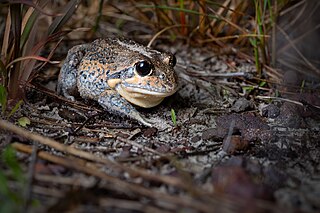
Limnodynastes dumerilii is a frog species from the family Limnodynastidae. The informal names for the species and its subspecies include eastern or southern banjo frog, and bull frog. The frog is also called the pobblebonk after its distinctive "bonk" call, which is likened to a banjo string being plucked. There are five subspecies of L. dumerilii, each with different skin coloration. The species is native to eastern Australia. There has been one occurrence in New Zealand, when tadpoles of the species were found in 1999 and destroyed.

Duellmanohyla is a genus of frogs in the family Hylidae found in Oaxaca, Mexico, as well as Central America. These are small stream-breeding frogs have bright red, bronze or yellow irises. Their dorsa are uniform pale green, olive, red-brown or lichenose, with green or olive spots on a black background. Several species have pale upper labial and lateral stripes. Some fingers or toes have moderate webbing.
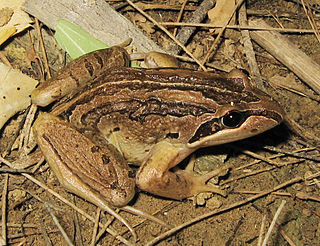
Limnodynastes is a genus of frog native to Australia, southern New Guinea and some Torres Strait Islands. They are ground-dwelling frogs, with no toe pads. The size varies from 45 mm to 90 mm in the giant banjo frog. The webbing on the feet ranges between species, from very little, to almost complete. The tympanum is not visible in any species, except in the woodworker frog, which is sometimes classed in a separate genus Megistolotis. All species construct a foam nest in which the eggs are laid. However, in south-eastern South Australia female striped marsh frog and spotted grass frog lack the flanges of skin on the hands that helps trap the air bubble and do not construct foam nests.

Fletcher's frog, commonly known as the sandpaper frog or black-soled frog, is a species of nocturnal, terrestrial frog native to eastern Australia. It is primarily found in wet sclerophyll forests along mountain ranges and the coast.

Gastrophryne carolinensis, the eastern narrow-mouthed toad, is a species of microhylid frog. It is a relatively small, toad-like amphibian found in damp, shady habitats. The species is highly fossorial, and feeds primarily on ants. These North American microhylids are distinguished from true toads, and other anurans by their moist, smooth skin, their lack of eardrums or tympana, their distinguishable squat body shape, and the unique fold of skin superior to their eyes. It is found in the United States, from southern Maryland to the Florida Keys, west to Missouri and Texas. While not a true toad, it is so called because it is terrestrial.
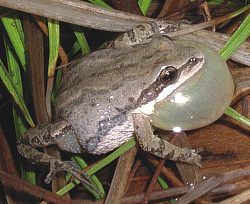
The western chorus frog, also known as striped chorus frog, or midland chorus frog is a species of frog found in Canada and the United States.
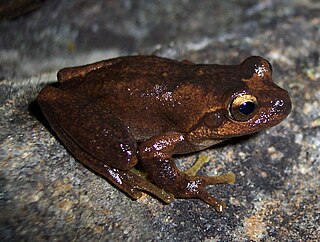
Littlejohn's tree frog, also called a heath frog or orange-bellied tree frog, is a species of tree frog native to eastern Australia from Wyong, New South Wales, to Buchan, Victoria.
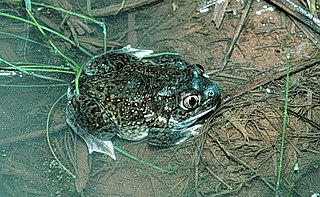
The plains spadefoot toad is a species of American spadefoot toad which ranges from southwestern Canada, throughout the Great Plains of the western United States, and into northern Mexico. Like other species of spadefoot toads, they get their name from a spade-like projection on their hind legs which allows them to dig into sandy soils. Their name, in part, comes from their keratinized metatarsals, which are wide instead of "sickle shaped". The species name translates as buzzing leaf shaped. This refers to the species' distinguishing features; its buzzing mating call, and its leaf-shaped digging metatarsals. It was first described by Cope in 1863.

Ranoidea australis, commonly known as the giant frog, northern snapping frog, or round frog, is a burrowing species of frog native to Australia. It occurs from western Queensland through to northern Western Australia.

The desert tree frog, or little red tree frog, is a species of tree frog native to Australia, southern New Guinea, and Timor. It is one of Australia's most widely distributed frogs, inhabiting northern Australia, including desert regions and much of temperate eastern Australia. It is one of the few Australian tree frogs to inhabit arid, tropical, and temperate climates.

The Sudell's frog, painted burrowing frog, trilling frog or desert trilling frog is a species of burrowing frog common to a large part of southeastern Australia. It is found on and west of the Great Dividing Range of New South Wales to western Victoria and southern Queensland, as well as far eastern South Australia, and southern regions of the Northern Territory.

The rough frog, also known as the woodland water-holding frog, warty water-holding frog, and red-backed cyclorana, is a species of treefrog native to northern New South Wales and south-eastern Queensland, Australia.

The long-thumbed frog, Fletcher's frog or barking marsh frog is a species of non-burrowing ground frog native to south-eastern Australia. The species belongs to the genus Limnodynastes. The twelve species in the genus are characterised by a lack of toe pads. Following phylogenetic analysis, the species was placed in L. peronii clade group alongside L. depressus, L.tasmaniensis and L. peronii.

Spencer's burrowing frog is a species of frog native to western and central Australia.

The knife-footed frog is a species of burrowing frog in the family Hylidae. It is endemic to Australia, where it is found over a wide area in the north of the continent.
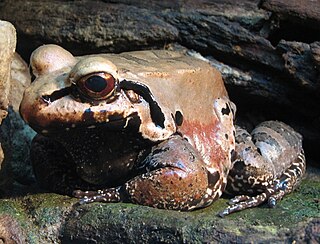
The smoky jungle frog is a species of frog in the family Leptodactylidae. It is found in Bolivia, Brazil, Colombia, Ecuador, Costa Rica, Panama, French Guiana, Perú and Venezuela. Its natural habitats are tropical and subtropical moist broadleaf forests, subtropical or tropical swamps, subtropical or tropical moist montane forest, rivers, freshwater marshes, intermittent freshwater marshes, and aquaculture ponds.
Otophryne steyermarki is a species of frog in the family Microhylidae. It is found in western Guyana and in the Bolívar state in eastern Venezuela.

Leptopelis spiritusnoctis is a species of frog in the family Arthroleptidae. It is found in West Africa from Guinea to the Niger Delta in Nigeria, the intervening countries being Sierra Leone, Liberia, Ivory Coast, Ghana, Togo, and Benin. This species was previously known as Leptopelis hyloides, but that name is actually a junior synonym of Leptopelis viridis.

Platyplectrum is a genus of ground-dwelling frog in the family Limnodynastidae. Species in this genus are found in Australia, New Guinea, and on the Aru Islands. They are medium-sized frogs and the dorsal skin has a sandpaper-like texture.






















